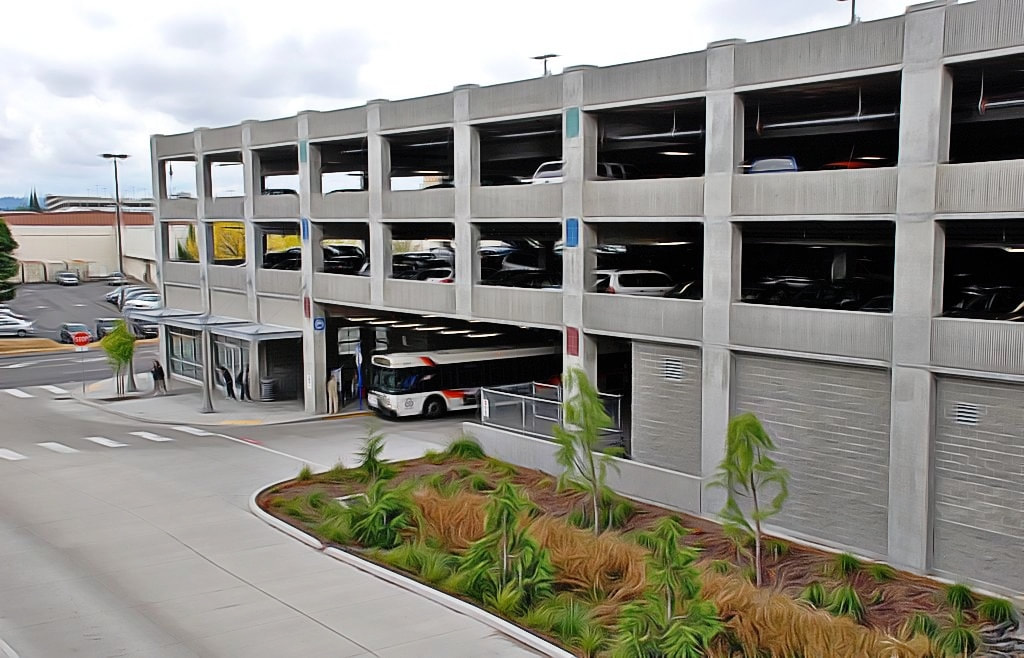|
For architects and engineers designing parking garages, two questions commonly arise when determining whether the garage should be an open or enclosed garage. These questions are:
When Can a Parking Garage Be Considered Open?Parking garages must meet all of the requirements of 406.5 to be considered open. In most cases, the limiting factor for an open vs. enclosed garage is meeting the opening requirements for natural ventilation. To achieve natural ventilation, an open parking garage must (IBC 406.5):
One additional point is that these opening calculations are for the free area of the openings. If a screen or other form of cover is applied to the opening, the free area ratio of the screen must be multiplied by the area of the opening to determine the free area. What are the differences in code requirements for an open garage vs. an enclosed garage?Key differences in the code requirements are: Ventilation Where open garages are naturally ventilated, closed parking garages require mechanical ventilation complying with the International Mechanical Code (IMC). Mechanical ventilation alone can add hundreds of thousands or even millions of dollars to a project. Sprinkler Protection Open parking garages are not required to be sprinkler protected. Enclosed parking garages require sprinkler protection in accordance with NFPA 13. If the garage is not maintained above 40 degrees Fahrenheit, a dry-pipe sprinkler system is required by NFPA 13. Both open and enclosed garages typically require standpipe systems. Enclosure of Vertical Openings Stairs serving an enclosed parking garage are required to be enclosed with rated construction similar to any other vertical opening in a building. In an open parking garage, enclosure of vertical openings, including stairs, is not required. In both cases, the vehicle ramps connecting levels are not required to be enclosed. Height and Area For an open parking garage used exclusively for parking (with an exception for a small office and waiting area at grade), the number of tiers and area is permitted to comply with IBC 406.5.4, which is an increase over the allowable height and area limits in IBC Chapter 5. The numbers in IBC Table 406.5.4 can be further increased when the garage has open sides on at least ¾ of the building perimeter. Enclosed garages cannot take this approach and must comply with the limits set forth in Chapter 5. Fire Resistance Ratings of Exterior Walls Both open and enclosed parking garages are required to comply with the exterior wall rating requirements of IBC 602. However, per Footnote C to IBC Table 602, open parking garages with a fire separation distance of 10 feet or greater are not required to have a fire-resistance rating. Enclosed parking garages do not have this exception and would require a 1-hour exterior wall unless the fire separation distance is 30 feet or greater. ConclusionAn open parking garage must meet the minimum requirements for both area of openings and perimeter of openings to allow for natural ventilation. If a parking garage does not meet these requirements, it is considered an enclosed garage and must be provided with mechanical ventilation, sprinkler protection, and it must also meet the other requirements listed above.
Need assistance on your specific project? Add Campbell Code Consulting to your team. They are a full-service code consulting and fire protection engineering firm that can help you navigate complex code challenges.
32 Comments
Melissa Spires
12/4/2020 01:34:59 pm
I have had a recent plan review that said the 20% open requirement had to occur on opposite sides of the garage. When I read the code, I do not interpret it that way. To me it reads that if you meet the 40% length requirement the 20% open area can be distributed however it wants. What is your interpretation.
Reply
Chris Campbell
12/18/2020 11:41:32 pm
Hi Melissa,
Reply
TK
1/29/2021 03:18:15 am
Great article. Can you point me to the code section that says vertical openings in enclosed garages need to be enclosed and open in open garages?
Reply
Chris Campbell
1/29/2021 11:09:46 am
Hi TK,
Reply
R. Todd Mann
11/29/2021 03:16:59 pm
Chris I note that stairways are not mentioned in 712.1.10. Can you advise where stairway enclosures are discussed with regard to unenclosed vertical openings?
Reply
Shelley House
2/12/2021 04:35:14 pm
Thank you for your article. I am interested in your comment about calculating free area when screens are added. These are becoming popular to “dress up” parking garages, but make it more challenging to meet opening requirements.
Reply
Chris Campbell
2/13/2021 09:34:38 pm
Hi Shelley,
Reply
Renee Clarke
4/28/2021 02:48:33 pm
Chris,
Reply
8/21/2021 09:54:18 pm
Hi Chris,
Reply
Chris Campbell
8/23/2021 08:32:59 am
Hi Cesar,
Reply
Linda Rumbaugh
8/27/2021 10:46:12 am
Can there be windows as openings, that tilt out for open?
Reply
Chris Campbell
8/27/2021 10:52:54 am
Hi Linda,
Reply
Tom Handle
8/29/2021 05:35:23 pm
I don't get why you wouldn't have sprinkler requirement on an open
Reply
Chris Campbell
8/30/2021 08:10:04 am
Hi Tom,
Reply
jesse
1/24/2023 04:18:51 pm
Does each floor in an open parking garage count as a fire area? Or do you have to combine all floors because the exterior walls are open? Meaning, Is the 48,000 sf limit for all floors combines or per floor.
ALAN
10/23/2023 12:45:41 pm
The IBC Commentary on the definition of Fire Area describes that if you do not have horizontal floors that are rated per 711.2.4 that separate the floors - i.e. you would not have that in a parking garage where the vehicle ramps act as vertical openings - then the aggregate Fire Area would include all floors combined.
Branden Piks
9/15/2021 09:38:22 am
In an enclosed garage, we have two 3-hr rated vertical stair shafts that go from level 6 to grade as part of a deck wrap apartment building. We have one instance where the second vertical shaft landing does not align with the parking deck and we need to add an interior stair in the deck, outboard of the rated shaft, to rise up 2'-2" to meet the landing for the rated shaft. I can't find anywhere in the code if this small, internal stair is required to be enclosed in a rated shaft as well or can remain open and connected to the rated shaft. The whole deck will be sprinklered. Any help or direction would be great!
Reply
Chris Campbell
9/15/2021 01:31:30 pm
Hi Branden,
Reply
Erika Sicam
10/11/2021 01:58:13 pm
Hello,
Reply
Chris Campbell
10/12/2021 03:48:53 pm
Hi Erika,
Reply
10/15/2021 09:05:01 am
Hi Chris
Reply
Eduardo Armijo Carvajal
1/26/2022 01:27:39 pm
All above suggestions are not true, if you are talking about Automated Car Parking Structure. There is not floors on this structure.
Reply
Kyle Walker
5/16/2022 11:52:59 am
Can you tell me what section of NFPA 13 says if temperatures are not maintained above 40 degrees then a dry-pipe system must be used? I am on a project with a consultant who is saying we need to heat trace all of our exposed sprinkler pipes because temperatures are not always maintained above 40 degrees. This is very expensive. They have told me they cannot use a dry-pipe system.
Reply
David
1/10/2023 03:41:08 pm
At Admirals Walk in Richmond, BC we have a gated garage. The openings are enclosed with fence material. No one can get into the garage except with a key or fob.
Reply
Donald
1/13/2023 05:02:44 pm
Working on a job site in Wellesley Massachusetts at 148 Weston road that has a under the building parking garage and the condo units above are still under construction and there's no fire prevention,no ventilation and CO detection system in place,the general contractor and the city of Wellesley are having the workers park in the yet not finished garage that is enclosed that can house more than 4 gasoline motor vehicles at times there's at least 8-10 vehicles house in the space. Should the workers be concerned about co poisoning?
Reply
2/17/2023 01:24:56 am
Thank you for giving me an idea about open and close garages. This is very much appreciated.
Reply
3/13/2023 02:41:36 am
Thank you for sharing this blog about open vs. enclosed parking garages. I am amazed by your ideas.
Reply
Gary S
6/12/2023 10:28:57 am
Chris,
Reply
Bilal Salahuddin
11/7/2023 08:34:13 am
If an open garage gets below 40 degrees Fahrenheit, for approx. 2 to 3 weeks in the entire year (e.g. Houston), then a dry-pipe sprinkler system is required or not.
Reply
Dave Compton
3/27/2024 07:06:47 am
If you have a 6 story open parking garage, is the elevator required to be backed up by a emergency generator.
Reply
Harold Scott
4/23/2024 05:24:20 pm
What is there is another building 3' away from one side of the garage. Would that side still be considered "open". Is there somewhere that say the adjacent building must be X feed away?
Reply
Leave a Reply. |
Categories
All
Sign up to receive Building Code Blog UpdatesArchives
July 2024
|
The Building Code Blog
- Home
- Blog
- About
-
Tools
- Allowable Height & Area Calculator - Non-Separated Mixed Occupancy
- Allowable Height & Area Calculator - Separated Mixed Occupancy
- Average Grade Plane Calculator
- Calculated Fire Resistance for Wood Walls
- Fire and Smoke Damper Tool
- Fire Wall/Exterior Wall Intersection Tool
- Frontage Calculator
- IBC Occupant Load Calculator
- Plumbing Fixture Calculator
- Stair Pressurization Estimator
HomeAboutBlogContact |
Copyright © 2019-2024 The Building Code Blog
The views, opinions, and information found on this site represent solely the author and do not represent the opinions of any other party, including the author's employer and the International Code Council, nor does the presented material assume responsibility for its use. Local codes and amendments may vary from the code requirements described herein. Fire protection and life safety systems constitute a critical component of public health, safety and welfare and you should consult with a licensed professional for proper design and code compliance.
|

 RSS Feed
RSS Feed
